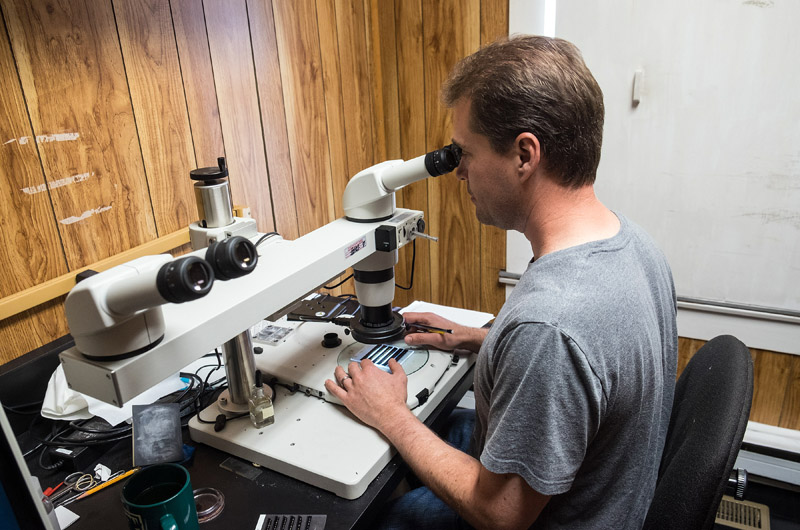The National Oceanic and Atmospheric Administration (NOAA) is zeroing in on a new home for its Northeast Fisheries Science Center, a mainstay in the culture and economy of Woods Hole. The federal agency said last week that it has narrowed its search to Barnstable County, which includes all of the Cape, and would keep the center closer to research partners in the area.
NOAA began assessing its Woods Hole complex more than a year ago, in light of dwindling office and laboratory space and other concerns. As a first step, a feasibility study is expected to be completed this summer or fall, although a final decision about whether and where to relocate is likely years down the road.
But NOAA representative Teri Frady told the Gazette that the process is moving forward.
“The analysis thus far has reviewed many locations across the region and based on needs and partnerships, Barnstable County has been selected as the best fit for a potential facility re-capitalization,” she said in an email.
The original list had included New Bedford, Narragansett, R.I., and Groton, Conn. In recent months since the plans emerged, officials in New Bedford and elsewhere have lobbied for NOAA to come to their towns, while the Falmouth selectmen have pleaded for the science center to stay put.
But it may not be as simple as picking up and leaving, said Bill Karp, the center’s director of science and research.
“There are a number of different options on the table,” Mr. Karp told the Gazette. “One possibility is that we would maintain some presence on the waterfront in Woods Hole, and then have a second facility upland. But there is a lot of moving parts to this.”
He said Woods Hole provides several benefits, most notably access to the waterfront for vessels, research and the Woods Hole Science Aquarium. But the current center, built in the 1960s, has run out of space. The buildings require constant maintenance, and summer traffic is an obstacle with the ferry terminal just up the road. Flooding in the area will likely become a greater hazard as sea levels rise.
“What we are looking for are modern, efficient facilities which will allow our staff to really provide the best science that they can and not be constrained by old facilities,” Mr. Karp said. “We’ve removed a lot of labs to create office space. We’ve got a lot of spaces that contain two or three people that should just contain one.”
NOAA also considered the burden on staff members, many of whom live in Falmouth, although proximity to the Woods Hole Oceanographic Institution and Marine Biological Laboratory were the main concerns. Mr. Karp said he did not know how many people commute from the Vineyard, but he believed it was very few. He did not believe any staff members live on Nantucket.
Narrowing the focus to the Cape is one step in a long process with an uncertain outcome. The feasibility study will set the stage for more detailed plans and a cost estimate, followed by continued discussion between NOAA and its umbrella agency, the Department of Commerce. Eventually, the project could be added to the federal budget and go to Congress for a vote. But there are no guarantees it will be funded.
“It will be quite a few years before construction begins, even under a best case scenario,” Mr. Karp said, adding that it was hard to guess what a new facility might cost.
When town leaders in Falmouth learned of the plans last winter, selectman Doug Jones sent a letter to NOAA stressing the importance of the Woods Hole facility to the town’s history, culture and economy. “For almost 150 years, the federal fisheries laboratory has been a stable, enduring presence in the village, giving rise to not only today’s NOAA Fisheries but to Woods Hole as the world-renowned center of marine science it is today,” he wrote.
He noted that Falmouth has already lost the NOAA survey ship Henry B. Bigelow to Newport, R.I., where it has been berthed since 2007.
New Bedford mayor Jonathan Mitchell later argued that moving the science center to his city could help heal some of the distrust many fishermen feel toward the agency. In a letter signed by a long list of city and state officials, he cited several concerns, including the ongoing stock assessments that often don’t match what fishermen say they observe, and an “ivory tower problem that has bred resentment” in the industry.
“Given the port’s unique status regionally and nationally, we believe that NOAA has an historic opportunity to reset its relationship with the fishing industry and create conditions for a new era of respect, trust and collaboration,” Mr. Mitchell wrote.
Chilmark selectman Warren Doty, who serves on the board of the Martha’s Vineyard Fishermen’s Preservation Trust, also noted the longstanding tensions between fishermen and NOAA Fisheries, which regulates the federal waters beginning three miles from shore.
“Fishermen argue all the time about whether the science is good science or not,” Mr. Doty said. “And it’s a difficult question.” As one example, he noted the annual bottom trawl surveys that some fishermen say don’t target the areas where fish live. But he agreed the research done in Woods Hole “is extremely important to good fisheries management.” He added that NOAA Fisheries has weighed in on every offshore wind project in the region, and that its recommendations helped refine the wind energy area south of the Vineyard to protect those fisheries.
Martha’s Vineyard officials have remained mostly silent on the relocation efforts so far, and the topic has not come up at meetings of the preservation trust. But Mr. Doty, for one, sides with Falmouth in hoping the science center stays put. He pointed out, among other things, that NOAA is the only research group in Woods Hole focused primarily on offshore fisheries.
“It would just be a shame to see Woods Hole change that much,” Mr. Doty said.










Comments
Comment policy »